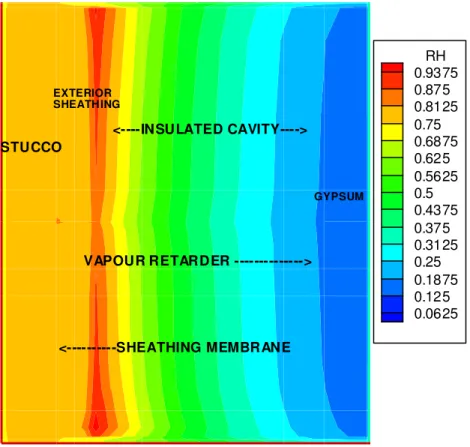Publisher’s version / Version de l'éditeur:
Construction Canada, 44, March 2, pp. 24-26, 30, 2002-03-01
READ THESE TERMS AND CONDITIONS CAREFULLY BEFORE USING THIS WEBSITE. https://nrc-publications.canada.ca/eng/copyright
Vous avez des questions? Nous pouvons vous aider. Pour communiquer directement avec un auteur, consultez la première page de la revue dans laquelle son article a été publié afin de trouver ses coordonnées. Si vous n’arrivez pas à les repérer, communiquez avec nous à PublicationsArchive-ArchivesPublications@nrc-cnrc.gc.ca.
Questions? Contact the NRC Publications Archive team at
PublicationsArchive-ArchivesPublications@nrc-cnrc.gc.ca. If you wish to email the authors directly, please see the first page of the publication for their contact information.
NRC Publications Archive
Archives des publications du CNRC
This publication could be one of several versions: author’s original, accepted manuscript or the publisher’s version. / La version de cette publication peut être l’une des suivantes : la version prépublication de l’auteur, la version acceptée du manuscrit ou la version de l’éditeur.
Access and use of this website and the material on it are subject to the Terms and Conditions set forth at
Protecting the long-term performance of building envelope
components
Kumaran, M. K.
https://publications-cnrc.canada.ca/fra/droits
L’accès à ce site Web et l’utilisation de son contenu sont assujettis aux conditions présentées dans le site LISEZ CES CONDITIONS ATTENTIVEMENT AVANT D’UTILISER CE SITE WEB.
NRC Publications Record / Notice d'Archives des publications de CNRC:
https://nrc-publications.canada.ca/eng/view/object/?id=ba61a34c-c015-4d7e-82d6-37f79beba10d https://publications-cnrc.canada.ca/fra/voir/objet/?id=ba61a34c-c015-4d7e-82d6-37f79beba10d
Protecting the long-term performance of building
envelope components
M.K. Kumaran
A version of this paper is published in / Une version de ce document se trouve dans:
Construction Canada, v. 44, no. 2, March 2002, p. 24-26, 30
www.nrc.ca/irc/ircpubs
Protecting the long-term performance of building envelope
components
By M.K. Kumaran
The building envelope has for many years been recognized as a system, whose role is multi-faceted and critical to long-term performance of the building itself. All components in the envelope continuously respond to changes in indoor and outdoor temperature, pressure and humidity conditions. This results in an exchange of energy and mass (air as well as moisture) between the indoor and outdoor environments through the envelope. Building physicists refer to this phenomenon as “heat, air and moisture transport” through building materials and
components.
Designers and builders are always interested in knowing the long-term performance of the building envelope, especially in terms of its response towards heat, air and moisture transport. Because global differences in construction practices, building materials, weather conditions and indoor climate are so large, it is impractical to develop this knowledge using only experimental investigations. However, such knowledge, as and when required, can be generated through calculations and computer simulations, supported by key experimental information. Building physicists, over the past four or five decades, have been attempting to develop reliable calculation methods for this purpose. These attempts, aided especially by the advances in computer technology, have resulted in a diverse set of procedures and computer models. At the National Research Council’s Institute for Research in Construction, a state-of-the-art computer model called hygIRC developed during the past decade now finds application as a tool in developing design considerations to prevent harmful moisture accumulations. The model can be applied to a variety of climatic conditions in North America.
hygIRC is based on well-known principles in building physics, such as Fourier’s Law of
heat conduction, Fick’s law of diffusion of matter and Darcy’s law of fluid flow. The fundamental equations are based on energy, mass and momentum conservations. A two-dimensional cross-section of the envelope component is captured in the computational domain as an ensemble of several hundreds of closely packed rectangular elements. The exterior of the envelope is subjected to hourly weather variations. Temperature, relative humidity, solar radiation, wind speed and direction, rain, are all accounted for. Wind-driven rain and unintentional rainwater entry into the envelope components are also simulated. Interior conditions are represented by temperature and relative humidity. Stack effect and airflow through unintentional openings are also considered. The model then simulates the response of each rectangular element to the changing environmental conditions, on an hourly basis. This produces information on
with time. These data are sampled at any desired intervals and visualized using the post-processing graphic modules in hygIRC. Such visualizations draw the attention of hygIRC users to identify locations within the assembly where unintentional moisture accumulation occurs. Furthermore, the duration of such occurrences and the prevailing temperatures at those locations are obtained from the computer simulations. These data can be combined with information on the onset of biological, chemical and mechanical deteriorations of various materials in the envelope component and the long-term performance can be predicted.
The reliability of the simulation results depends on two key sets of inputs: the heat, air and moisture transport properties of each building material in the envelope component and the environmental or boundary conditions. hygIRC has separate modules that help the user to select these two sets of inputs correctly. Standard experimental procedures used at the Institute give very reliable and detailed information on all transport properties of building materials in use today. A software called WeatherSmart, developed at the Institute, helps the user to analyze multi-year weather records from any location and to select the exterior and interior environmental conditions that are most appropriate to the problem being investigated.
In a recent study at the Institute, hygIRC was used to investigate the influence of the vapour permeances of sheathing membranes and vapour retarders on the moisture response of stucco-clad wood-frame walls. Ottawa and Vancouver were chosen for the preliminary
investigation. Weather analyses for this investigation resulted in 1969 as the moisture reference year for Ottawa and 1980 for Vancouver. The two-dimensional cross section of the wall used in
hygIRC simulations is shown in Figure 1. This cross section was reconstructed as an assembly
of approximately 650 rectangles in the computer model. A fixed set of representative
hygrothermal properties that were determined at the Institute was used for all components except for the vapour retarder and sheathing membrane. For the latter two components, a range of values for the vapour permeance experimentally determined at the Institute and to represent the commercially available products was chosen for the parametric analyses. In the simulations, hourly weather data from each location were used to define the exterior environmental conditions. Also, appropriate interior temperature and relative humidity were used for both locations.
Simulations resulted in information similar to that shown in Figures 2 and 3, which show a cross section of the wall (width enlarged for clarity) in early January in Ottawa, in terms of the relative humidity distribution within the wall.
The relative humidity distribution within the wall is affected by the choice of the vapour retarder, everything else remaining the same. This is only one snapshot of the information that
hygIRC can provide. Similar information on temperature distribution and moisture content
distribution is also provided for multiple years at regular chosen intervals. It is this information that enables the user to predict the long-term performance or suggest design considerations for better moisture management of building envelope components.
The preliminary investigation mentioned above has helped the researchers to make the following conclusions:
(1) The range of water vapour permeance (WVP) of the sheathing membrane considered in the study and representative of the products currently available in the market has no significant influence on the overall moisture content and its distribution in stucco-clad wood-frame wall. (2) Unlike the sheathing membrane, WVP value of the vapour retarder has more telling effects
on the overall wetting and drying pattern of the wall.
(3) Vapour retarders with higher WVP values increase the moisture content of the wall during the wetter period of the season but do not lower the minimum moisture content during the driest period of the season.
(4) Most of the moisture accumulation due to increased WVP values of the vapour retarder occurs in the wood-based sheathing board.
(5) The weather pattern in a particular location has an important role in the selection of the optimum WVP value for a vapour retarder.
Further detailed investigations for a variety of Canadian locations and with the full range of hygrothermal properties of all materials in the wall assembly will help us to provide better design considerations in terms of vapour diffusion control strategies for stucco-clad wood-frame
constructions in Canada.
Dr. M.K. Kumaran is a principal research officer in the Building Envelope and Structure Program of the National Research Council’s Institute for Research in Construction.
Figure 1. A two-dimensional cross section of the stucco-clad wood-frame wall captured by the computer model hygIRC for simulations.
2400 mm
Top Plate, Spruce Gypsum Board
Vapour Retarder
Insulated Stud Cavity [89 mm]
Exterior Sheathing
Sheathing Membrane
Stucco Cladding
RH 0.9375 0.875 0.8125 0.75 0.6875 0.625 0.5625 0.5 0.4375 0.375 0.3125 0.25 0.1875 0.125 0.0625 H E IG H T (2 .4 m ) EXTERIOR SHEATH ING <----INSULATED CAVITY----> STUCCO WIDTH (APPROXIMATELY 135 mm) <---SHEATHING MEMBRANE VAPOUR RETARDER ---> GYPSUM
Figure 2. Two –dimensional cross-section of a stucco-clad wood-frame wall in Ottawa, in terms of the relative humidity distribution in early January; note that the width of the wall is expanded for clarity. The permeance of the vapour retarder in this wall is 500 ng m-2 s-1 Pa-1.
RH 0.9375 0.875 0.8125 0.75 0.6875 0.625 0.5625 0.5 0.4375 0.375 0.3125 0.25 0.1875 0.125 0.0625 H E IG H T (2 .4 m ) EXTERIOR SHEATH ING <----INSULATED CAVITY----> STUCCO WIDTH (APPROXIMATELY 135 mm) <---SHEATHING MEMBRANE VAPOUR RETARDER ---> GYPSUM
Figure 3. Two –dimensional cross-section of a stucco-clad wood-frame wall in Ottawa, in terms of the relative humidity distribution in early January; note that the width of the wall is expanded for clarity. The permeance of the vapour retarder in this wall is only 45 ng m-2 s-1 Pa-1. The effect of the reduced permeance of the vapour retrader is evident because the exterior sheathing is very dry in comparison with that in Figure 2.
WeatherSmart: A Weather
Analysis Tool from IRC
The main purpose of WeatherSmart is to facilitate the analysis of the outdoor weather data for many years from a given location and to obtain representative environmental boundary conditions, outdoor as well as indoor, for
hygIRC simulations. These conditions are
necessary for the analysis of long-term heat, air and moisture responses of building envelope materials and components, performed for thermal and moisture design. The environmental boundary conditions generated are location-specific and for the expected usage of the building considered. Several approaches to characterise either the indoor or the outdoor environmental conditions are part of the tool. The different approaches allow analysis of the environmental conditions that apply moisture and thermal loads on the particular envelope component being studied. Construction-dependent and inConstruction-dependent methods for selecting the outdoor moisture reference years have been incorporated in the tool. The tool includes a one-dimensional version of hygIRC for rapid simulations of hygrothermal responses on building envelope components, to assess the effect of weather variations from year to year on such responses. The indoor environment, representing the expected usage of the building under consideration, is derived for both controlled and uncontrolled situations.


